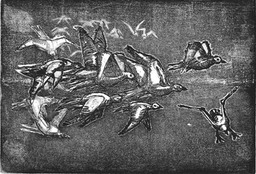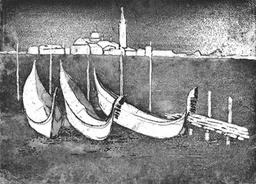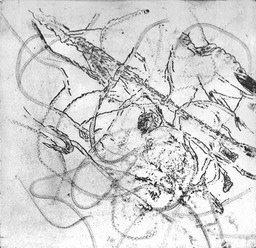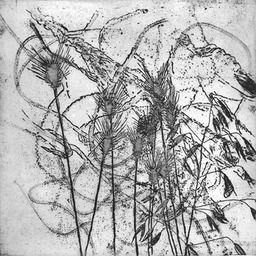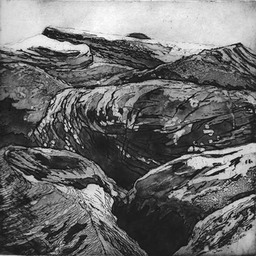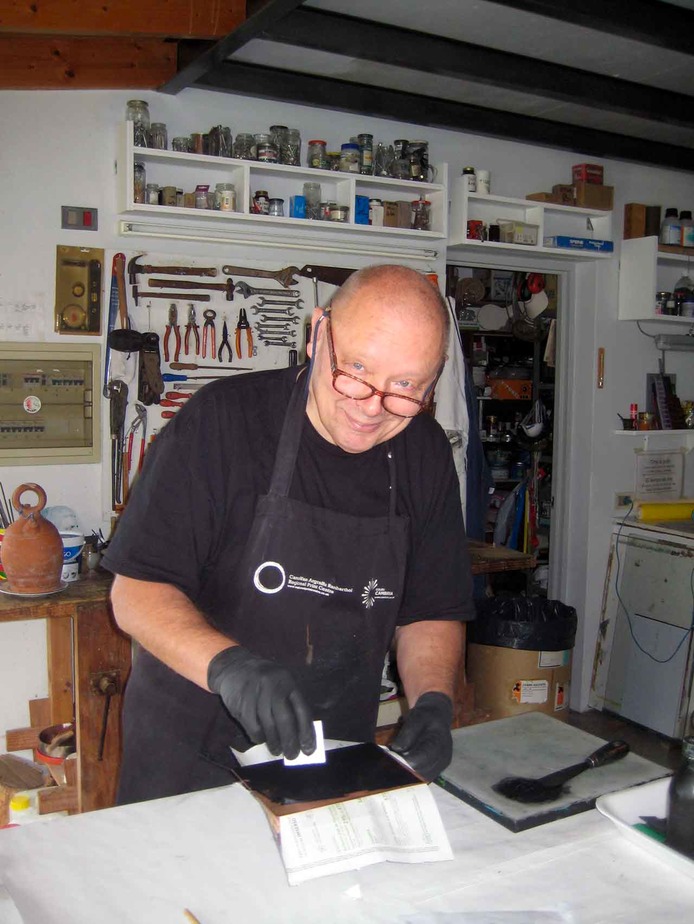
Bernhard Cociancing has taken two years to come to the residence workshop as a result of the restrictions derived from the Covid-19 pandemic. Well, but at last he has arrived at the island of Gran Canaria that he liked so much.
He is an Austrian artist who spent forty years working in the oil industry as an engineer. Self-taught artist who graduated in 2018 in fine arts at the Vienna Art School, a wish he had since his youth and that he could not realize before. His main interest is graphic art, and especially the safest processes for printmakers and the environment. He is also evidently interested in nature conservation. You can see that on his website the topics he deals with in his works and the graphic processes in which he is interested: Linoleum, intaglio etching, silk-screen print and a process of lithography on wood "Mokulito" in which he is more than interested, he has even written a report on the technique in English, which I have dared to translate into Spanish. During his stay he generously offered me a very interesting practice of this technique.
He had already practiced electro-etching for some years. He told me he had bought my Electr-etching hand-book, when it could still get it in paper on Amazon.com (today it is only available in Kindle format). He set up a electro-etching unit with which he practiced electrolysis on several metals (steel, aluminum and zinc) and with different electrolytes (mordants). These experiences made him contact me and he planned his stay in advance to practice in my workshop the electrolytic processes that I work on.
Actually Bernhard behaved in my workshop as an experimenter, he did not really seek to make "aesthetic works of art" he preferred to test processes that he did not know and some other variant. He practiced on copper plates lines on hard ground (liquid) Charbonnel, the tonal areas of open bites (electrotint), without pulverization of asphalt or rosin. Graphite ink as a varnish (even he preparing a mixture with graphite powders that gave good results) and Mezzotint on a plate whose surface was grained by galvanizing.
I think that Bernhard has left very satisfied with his graphic experience and his visits to different places on the island.
Pictures from the workshop
Bernhard Cociancig speaks about his experience in the workshop-residency
Auf meiner Suche nach innovativen, experimentellen, umweltfreundlichen und ressourcenschonenden Druckgrafikmethoden entdeckte ich vor einiger Zeit die Technik des Elektro-Ätzens: außer dem Buch von Alfonso Crujera (das inzwischen leider vergriffen ist und nur noch als Kindle-Version bezogen werden kann) gab es relativ wenig und nur ungenaue Informationen darüber in der Public Domain, aber mit dem spärlich Vorhandenen begann ich ein paar Monate vor dem Ausbruch der Pandemie meine ersten Versuche: nach dem Eigenbau von vertikalen Ätztanks und der Anschaffung eines Regeltrafos unternahm ich erste Versuche mit Elektro-Ätzen, anfangs nur mit Kupferplatten, später aber auch mit anderen Metallen (Stahl, Aluminium und Zink). Die Ergebnisse waren sehr befriedigend und vor allem die Arbeiten mit Stahl konnten mich überzeugen, dass es auch ohne gefährliche Chemikalien (Salpetersäure) möglich ist, gute Resultate mit diesem doch recht billigen und einfach herzustellenden Grundmaterial zu erzielen. Um meine Kenntnis über Elektro-Ätzen zu verbessern, hatte ich für Herbst 2020 einen Workshop bei Alfonso gebucht – der damals (wie so vieles andere) der Pandemie zum Opfer fiel. Nach einer „Verspätung“ von zwei Jahren gelang es dann aber doch im Oktober 2022 nach Gran Canaria bzw dem Studio und Haus von Alfonso und Ampero in San Felipe an der Nordküste der Insel zu kommen:
Alfonso holte mich am Airport ab und bereits auf der Fahrt in die Residency konnte ich sehen, ich welch beindruckender Umgebung sein Studio (und sein Wohnhaus) lagen. Der Ausblick von hier auf den Atlantik ist einfach umwerfend und die Brandung bringt eine ständige akustische Untermalung zu den visuellen Eindrücken. Alfonso und Amparo, ihr Sohn und dessen Familie sowie ihre zahlreichen befreundeten Familien machten den Aufenthalt abwechslungsreich. Und natürlich konnte Alfonso mir neben den bereits gemachten Erfahrungen im Elektro-Ätzen noch zahlreiche Tricks of the Trade zeigen, die ich gerne nach Hause nehmen werde. Besondere Freude hat mit gemacht, dass sich Alfonso für eine andere von mir betriebene alternative Drucktechnik des Mokulito interessierte: er war sogar so freundlich, meine Beschreibung dieser Technik ins Spanische zu übersetzen! Nach der Suche nach geeignetem Sperrholz konnten wir sogar ein kleines praktisches Beispiel des Prozesses im Studio durchführen.
HAPPY PRINTING
------------------------------------ English translation by Bernhard Cociancig --------------------------------------
In my search for innovative, experimental, environmentally and resources-friendly methods of print making, I came across the technique of electro-etching a while ago: except the book by Alfonso Crujera (which unfortunately is out of print in the meantime and can only be acquired in a Kindle version), the publically available information was scarce and relatively inaccurate, but with the little I had at hand I started my first attempts a few months before the outbreak of the pandemic. After having built my own vertical etching tanks and the acquisition of a transformer, I started my first tests with e-etching – initially with copper plates, but later extending my tests to other metals (steel, aluminum and zinc). The results turned out to be quite encouraging and in particular the works with steels were able to convince me, that it is possible to achieve good results with this relatively cheap base material without the need for hazardous chemicals (nitric acid). In order to hone my knowledge on e-etching, I had booked a workshop with Alfonso for autumn 2020 – and then the pandemic hit and we had to postpone the plans (as so many other things). After a “delay” of some two years, I came to Gran Canaria and the studio and house of Alfonso and his spouse Amparo in San Felipe on the Northern Coast of the island in October 2022:
Alfonso met me at the airport and already on the way to the residency one could see, how impressive the environs of the studio (and his home) are. The view from here onto the Atlantic is simply mind-boggling and the surge of the waves provides a permanent background to the visual impression. Alfonso and Amparo, their son and his family as well as numerous friends made the stay most diversified. And of course, Alfonso was able to add a lot of his tricks of the trade to my already made experiences in e-etching which I will most gladly will take back home. I was especially happy that Alfonso was interested in a further alternative printmaking technique, Mokulito which I am pursuing and practicing since quite a while: he was even prepared to translate my description of the process into Spanish! After some search for suitable plywood, we were even able to do a brief demonstration of this process.
Aside from the work in the studio I had the opportunity to see the vistas of Gran Canaria and I can only recommend to all artists, to set aside a few days during their stay to do some sightseeing of this great island.Neben den Arbeiten im Studio hatte ich auch die Gelegenheit, einen Teil von Gran Canaria zu besichtigen und ich kann nur allen Künstler*innen raten, in ein paar Tagen ihres Aufenthalt die Sehenswürdigkeiten von Gran Canaria zu besuchen.
HAPPY PRINTING
Bernhard Cociancig's electro-etching
